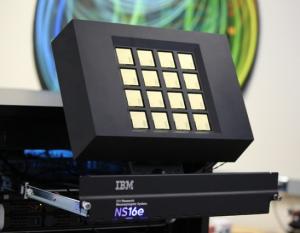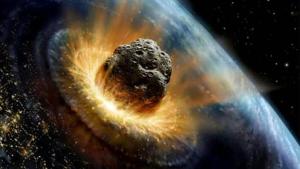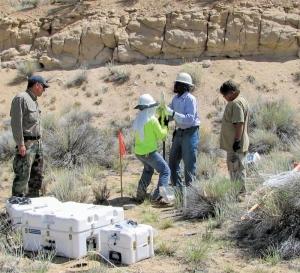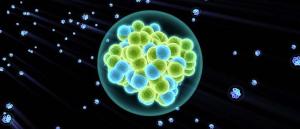LAB REPORT
Science and Technology Making Headlines
April 1, 2016


The 16-chip IBM TrueNorth platform that Lawrence Livermore will receive. The scalable platform will process the equivalent of 16 million neurons and 4 billion synapses and consume the energy equivalent of a hearing-aid battery — a mere 2.5 watts of power. Photo courtesy of IBM
Supercomputing on the brain
Lawrence Livermore National Laboratory is getting a boost from the human brain to solve some of the world’s toughest computing problems.
The Lab will begin testing the computer, the first of its kind, packed with 16 microprocessors that are designed to mimic the way the brain works.
The chip, called TrueNorth, introduced by IBM in 2014, is a scalable platform that will process the equivalent of 16 million neurons and 4 billion synapses and consume the energy equivalent of a hearing aid battery — a mere 2.5 watts of power.


Pacific and Atlantic southern sections showing upper-ocean warming for the past six decades (1955-2011). Red colors indicate warming and blue colors indicate cooling. Image by Timo Bremer/LLNL.
Double trouble in the deep ocean
Lawrence Livermore scientists, working with the National Oceanic and Atmospheric Administration and university colleagues, have found that global ocean heat content since 1865 has doubled in recent decades.
“In recent decades the ocean has continued to warm substantially, and with time the warming signal is reaching deeper into the ocean,” said LLNL scientist Peter Gleckler, leader of the research.
Changes in ocean heat storage are important because the ocean absorbs more than 90 percent of the Earth’s excess heat increase associated with global warming. The observed ocean and atmosphere warming is a result of continuing greenhouse gas emissions. Quantifying how much heat is accumulating in the Earth system is critical to improving the understanding of climate change already underway and to better assess how much more to expect in decades and centuries to come.


An artist's illustration of asteroids, or near-Earth objects. Credit: ESA - P.Carril
Thwarting an asteroid encounter
One day, maybe without warning, a rogue asteroid could slam into our planet and wipe out civilization.
While the risk of such an event is slim, the consequences could be catastrophic. For this reason, scientists around the world are tossing around their best ideas on how best to steer asteroids off course to thwart a potential collision.
One of the most promising involves literally crashing a speeding spacecraft into a dangerous space rock. It's called the "kinetic impact" technique and, in a new study, planetary geoscientist Megan Bruck Syal and her team at Lawrence Livermore National Laboratory have taken a big step toward showing it just might work.


Scientists place gas sample tubes at a former underground nuclear explosion site in Nevada.
Sniffing out underground nuclear explosions
Scientists have improved their ability to detect underground nuclear explosions set off by rogue nations.
A team led by Charles Carrigan at Lawrence Livermore National Laboratory used field experiments to build a new, complex model that predicts isotopic ratios of noble gases that would be released from such explosions. These gases would be carried away in the atmosphere after an explostion and investigators could look for the isotopic signatures thousands of kilometers away from the test site and even months afterward.
In the new work, Carrigan’s team injected gas tracers into an old cavity in Nevada created by an underground nuclear explosion and studied how the gases were transported and released from the cavity.


Element 117, first discovered by Lawrence Livermore researchers and Russian collaborators, has been confirmed by the International Union of Pure and Applied Chemistry.
And the periodic table goes on
The International Union of Pure and Applied Chemistry recently announced the addition of four new elements to the periodic table of elements, which will sit in spots 113, 115, 117 and 118. Lawrence Livermore was part of the teams that discovered 115, 117 and 118.
For a long time, the periodic table rarely added elements. After World War II and the Manhattan Project, however, scientists realized they could use nuclear processes to create elements that never before existed. Essentially, they found a way to stuff more protons into the nucleus.
Scientists at the large colliders, like the Joint Institute for Nuclear Research in Russia and RIKEN in Japan, shoot atoms at one another in hope that they can get that extra proton in the nucleus. And they have. The new element in slot 113 has 113 protons; the new element in 118 has 118 protons.





